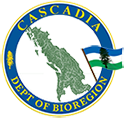BURDASH
[BUR-dash] or [BAR-dash] — noun.
Meaning: Hermaphrodite; intersex; neuter; genderless.
Origin: Canadian French berdache > Italian bardassa > entering European languages via Moorish Spain from Arabic bardaj, “slave” > Persian bardah, “prisoner”.
In Chinook Wawa, the word burdash was commonly used to refer to accidental or incidental hermaphroditism or lack of gender, such as by castration, “burdash cayoosh” (gelding), and “burdash moos-moos” (steer), or unusual birth, as seen in “burdash kiuatan” (mule).
The word also saw extensive use as a sociological term for those that assumed the gender identity of the opposite sex. Alternative gender roles were widely shared feature of many native cultures, with documented examples in over 155 First Nations in the US and Canada. In about a third of these groups, a formal status also existed for females who undertook a man’s lifestyle, becoming hunters, warriors, and chiefs. They were sometimes referred to with the same term for male berdaches and sometimes with a distinct term—making them, therefore, a fourth gender. (Thus, “third gender” generally refers to male berdaches and sometimes male and female berdaches, while “fourth gender” always refers to female berdaches.)
Because so many First Nation cultures were disrupted, or had disappeared before they were studied by anthropologists, it is not possible to know the absolute frequency of these roles. Those alternative gender roles that have been documented, however, occur in every region of the continent, in every kind of society, and among speakers of every major language group.
“Berdache” had become the accepted anthropological term for these roles despite a rather unlikely etymology; it can be traced back to the Proto-Indo-European root *wela– “to strike, wound,” from which the Old Iranian *varta-, “seized, prisoner,” is derived. In Persia, it referred to a young captive or slave (male or female). The word entered western European languages perhaps from Muslim Spain or as a result of contact with Muslims. By the Renaissance it was current in Italian as bardascia and bardasso, in Spanish as bardaje (or bardaxe), in French as berdache, and in English as “bardash” with the meaning of “catamite”— the younger partner in an age-differentiated homosexual relationship. Over time its meaning began to shift, losing its reference to age and active/passive roles and becoming a general term for male homosexual. In some places, it lost its sexual connotations altogether. By the mid-nineteenth century, its use in Europe lapsed almost completely.
In North America, however, “berdache” continued to be used, but for a quite different purpose. Its first written occurrence in reference to third and fourth gender North American natives is in the 1704 memoir of Deliette. Eventually, its use spread to every part of North America the French entered, becoming a pidgin term used by Euro-Americans and native people alike.
Although there are important variations in berdache roles, they all shared a core set of traits:
Specialized work roles. Male and female berdaches were typically described in terms of their preference and achievements in the work of the “opposite” sex and/or unique activities specific to their identities.
Gender difference. In addition to work preferences, berdaches were distinguished from men and women in terms of temperament, dress, lifestyle, and social roles.
Spiritual sanction. Berdache identity was widely believed to be the result of supernatural intervention in the form of visions or dreams, and/or it was sanctioned by tribal mythology.
Same-sex relations. Berdaches most often formed sexual and emotional relationships with non-berdache members of their own sex.
The first use of the term in an anthropological publication was by Washington Matthews in 1877. In describing Hidatsa miáti he wrote, “Such are called by the French Canadians ‘berdaches.’” The next anthropological use was in J. Owen Dorsey’s 1890 study of Siouan cults. Like Matthews, he described “berdache” as a French Canadian frontier term, and following Alfred Kroeber’s use of the word in his 1902 ethnography of the Arapaho, it became part of standard anthropological terminology when discussing or referencing a person who identifies with any of a variety of gender identities which are not exclusively those of their biological sex.
In recent years the term has come to be considered offensive by many First Nations communities because of its pejorative and non-native etymology. In 1993, a group of anthropologists and natives issued guidelines that formalized these preferences. “Berdache,” they argued, is a term “that has its origins in Western thought and languages.” Scholars were encouraged to drop its use altogether, and instead use the word “two-spirit”, a modern word coined from the Ojibwa niizh manidoowag, or use tribal specific terms for multiple genders. Today the term “two-spirit” is identified as the preferred label of contemporary gay, lesbian, bisexual, and transgender native peoples.





Post a comment